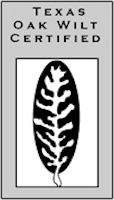Large Cracks and Holes in Tree Trunks
Mature trees sometimes have large roundish holes or vertical cracks in their trunks. Sometimes the tree manages to seal over a wound in its trunk, and it will be just fine. Other times, the tree needs a little help to control the damage.
What Causes Large Holes in Trees?
Large holes in tree trunks are generally the result of improper pruning – a large limb was removed, and the cut was too close to the tree’s trunk.
Branches attached to a tree’s trunk have a collar. The collar is like a shoulder in between the branch and the trunk. If you remove a large limb, the collar should be left intact. If the cut is flush with the trunk, the tree will decompose the wound inwards. This decomposition creates a hole.
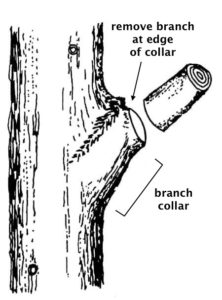
Should You Repair a Tree Trunk Hole?
Sometimes owls or ducks will make a nest in a large hole. Some people don’t want to fill the hole for this reason.
Some holes are problematic. If a hole doesn’t seal correctly, it lets water get inside of the tree. This can cause rapid decay. In this case, filling the hole will generally extend the life of the tree.
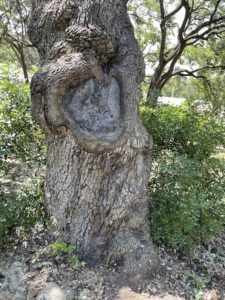
What Causes Vertical Cracks in Tree Trunks?
Vertical cracks in trees can be caused by lightning strikes, freeze/thaw cycles, or construction damage.
Central Texas ice storms have heavy rain followed by a sudden freeze. The trunk fills with rain water. The water expands when it freezes, and the tree trunk cracks.
Eventually, the bark will start to peel off around the crack, and the damage will become visible. It can take 6 – 24 months to notice a damaging crack.
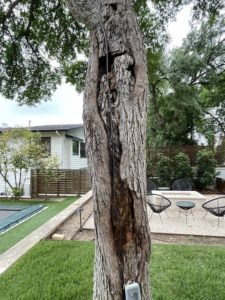
Should You Repair a Tree Trunk Crack?
Trees don’t heal, they seal. 9 out of 10 times the tree will seal over the damaged crack and be just fine.
Sometimes the tree, for whatever reason, needs a little help. A crack with jagged edges can’t close properly. Water will get inside the crack, and cause further damage to the tree. Exposed wood can also allow bugs to bore into your tree and do harm. These problematic cracks should be repaired to extend the life of your tree.
Cracks in large oak trees should always be sealed.
How Do You Repair Holes and Cracks in Tree Trunks?
When we fill a hole or crack in a tree trunk, we first clean the crack – we remove dead or wet wood, and smooth the edges of the wound. We also remove any loose bark, so bugs can’t bore into the tree.
Once the wound is clean and dry, we fill it with expanding foam – never concrete! The foam needs to dry for 3-10 days, depending on the size of the wound.
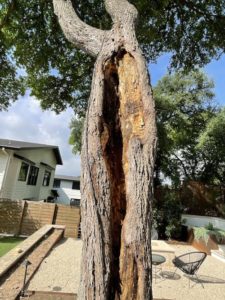
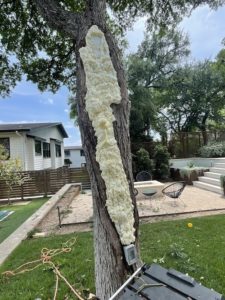
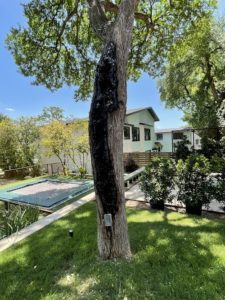
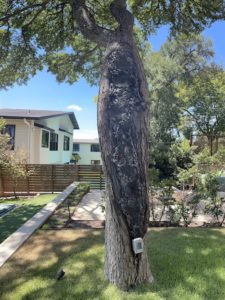
When the foam is dry, we trim it to enhance its appearance, and make it blend in with the rest of the tree trunk.
We then seal the foam with black sealer paint, and finish with brown or gray paint to match the tree.
While we are filling the crack, we also do routine maintenance by pruning the tree’s deadwood.
Finally, we give the tree a fertilizer treatment to help the bark more quickly seal its wounds.
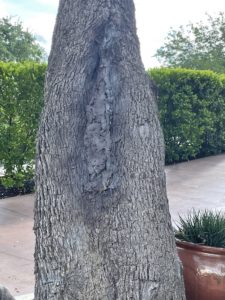
How Much Does It Cost to Repair a Tree Trunk?
If we are on your property doing other tree work, we can generally repair a medium size hole for around $200 + materials.
For standalone repairs, please contact us for a free estimate. The cost of the repair will always depend on the tree’s location, the size of the crack or hole, and the amount of existing damage.
How Long Do Tree Trunk Repairs Last?
We don’t know because all the trees we’ve repaired are still alive!
No one can guarantee the life of your tree. But problematic cracks or holes in your tree – wounds the tree has not managed to naturally seal by itself – will lead to further damage, and cause your tree to die more quickly.
Do You Need Tree Trunk Repair?
Free On-Site Estimates
7am – 7pm
7 days a week



